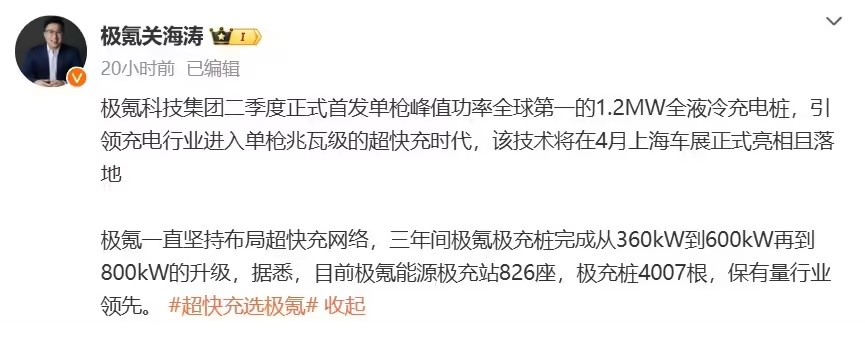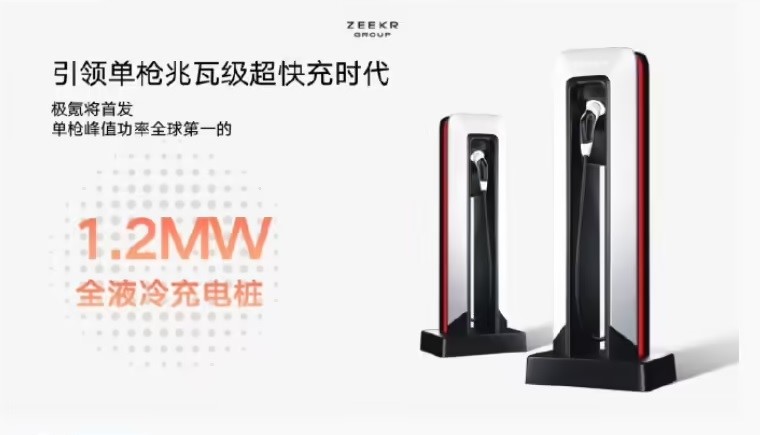At the China Electric Vehicle 100 Forum, ZEEKR Technology Group released the world's first fully liquid-cooled ultra-fast charging pile with a peak power of up to 1.2MW for a single gun. This innovation not only represents a new level of charging technology, but also arouses widespread interest in the industry about the future of ultra-fast charging. So, can this technology really solve users' charging anxiety? How will it affect the competitive landscape of the industry? In this article, China Exportsemi will try to conduct in-depth analysis from the perspectives of technological breakthroughs, industry competition, market layout and future trends.

Figure: ZEEKR Technology Guan Haitao issued a document saying that in the second quarter, it will officially launch the 1.2MW fully liquid-cooled charging pile with the world's largest peak power of a single gun
1. Technological breakthrough: the realization of single-gun megawatt-level ultra-fast charging
The biggest technical highlight of the ZEEKR 1.2MW fully liquid-cooled charging pile is its world-leading single-gun peak power. This breakthrough relies on an efficient liquid cooling system, which can effectively suppress the heat generated during high-power charging and ensure the stable operation of the charging equipment.
According to the official data of ZEEKR, the charging pile can achieve the ultra-fast charging goal of "charging for 5 minutes and a range of 400 kilometers", greatly shortening the charging time. However, the realization of megawatt-level ultra-fast charging faces multiple challenges, especially the heat generation and loss caused by high currents. The traditional air-cooled heat dissipation technology has been difficult to meet the needs of high-power charging, while the liquid cooling technology adopted by ZEEKR takes away the heat through the circulating flow of coolant to ensure the safety and durability of the charging equipment under high-power operation.
In addition, this technology of ZEEKR also combines an intelligent battery management system (BMS), which can adjust charging parameters in real time, improve energy transmission efficiency, and reduce battery loss. This full-link optimization strategy not only improves the charging experience of users, but also sets a new technical benchmark for the entire industry.

Figure: ZEEKR Technology's 1.2MW fully liquid-cooled charging pile
2. Industry competition: compared to Tesla V4 Supercharger
In the field of ultra-fast charging, Tesla has been one of the world's leading companies. The peak power of a single gun of its V4 super charging pile is 350kW, which is still a big gap compared with the technical specifications of ZEEKR of 1.2MW. However, the competition in charging technology is not only about power parameters, but also about the breadth of the charging network and the user experience.
Tesla's network of Superchargers has covered more than 30,000 charging stations around the world, forming a solid charging ecosystem. In contrast, ZEEKR's charging network is still in the expansion stage, but it is growing rapidly. According to the data, by the end of 2023, ZEEKR has built 826 pole charging stations, deployed 4,007 pole charging piles, and plans to exceed 10,000 charging piles by 2026. This expansion strategy means that although Zeekr temporarily lags behind Tesla in scale, its leadership in ultra-fast charging technology is expected to give it a competitive advantage.
In addition, ZEEKR's liquid cooling solution is also better than Tesla's current air-cooling system, which can effectively reduce the thermal management problem during high-power charging. In the future, with the intensification of competition in the electric vehicle market, the advantages and disadvantages of ultra-fast charging technology will become an important factor in the competition of car companies.
3. Market layout: Evolution path from 360kW to 1.2MW
ZEEKR's layout in ultra-fast charging technology was not achieved overnight, but has undergone multiple stages of continuous evolution. From the early 360kW fast charging pile, to 600kW, 800kW, and now to the 1.2MW ultra-fast charging, ZEEKR has deepened its technology accumulation in the field of high-power charging.
In addition to self-built charging piles, ZEEKR has also adopted a "self-built + cooperative" model, cooperating with a number of third-party charging network operators to improve the availability of charging stations. This strategy not only enables the rapid expansion of the charging network, but also improves the convenience of users.
It is worth noting that the coverage of ZEEKR's charging network is gradually extending to highways, core city business districts and major travel hubs, further optimizing the layout of charging facilities and improving the application efficiency of ultra-fast charging technology.
4. User needs: Can ultra-fast charging end charging anxiety?
Although the market penetration rate of electric vehicles continues to increase, "charging anxiety" is still an important factor hindering consumers from purchasing new energy vehicles. According to the China Association of Automobile Manufacturers, the penetration rate of the domestic new energy passenger vehicle market will reach 47.6% in 2024, but the proportion of pure electric vehicles will drop from 82.9% in 2020 to 58.4%, indicating that users still have concerns about the coverage of the charging network and the charging speed.
The launch of ZEEKR 1.2MW ultra-fast charging is a solution to this pain point. The greatly shortened charging time makes electric vehicles close to or even surpass the refueling experience of traditional fuel vehicles in terms of energy replenishment efficiency. Especially in high-demand scenarios, such as highway service areas and intercity transportation hubs, the implementation of megawatt-level ultra-fast charging technology is expected to greatly reduce users' range anxiety.
However, there are still many challenges to the rollout of ultra-fast charging technology, including:
Grid load problem: Charging piles with megawatt power put forward higher requirements for grid infrastructure, and need to be equipped with smart grids or energy storage systems.
Equipment cost and maintenance: The R&D and maintenance costs of high-power charging piles are high, and how to control costs and improve operational efficiency will be a key consideration for car companies and charging operators.
Compatibility and standardization: At present, there are still differences in the fast-charging standards of various car companies, and how to promote unified industry standards so that vehicles of different brands can seamlessly adapt to megawatt-level fast charging piles still needs to be further explored.
5. Future outlook: Leading the era of ultra-fast charging and promoting industry change
ZEEKR's 1.2MW fully liquid-cooled charging pile is scheduled to be officially unveiled at the Shanghai Auto Show in April 2025 and will be gradually implemented. The successful promotion of its ultra-fast charging technology may trigger a new round of charging technology upgrading trend and promote the industry to enter the era of megawatt charging.
However, to truly end charging anxiety, technological breakthroughs are only the first step, and how to improve infrastructure construction, improve grid adaptation, and promote the unification of industry standards are still the key factors that determine the future development of ultra-fast charging.
Overall, the release of ZEEKR's 1.2MW fully liquid-cooled charging pile not only represents the top level of technological innovation, but also may become an important turning point in the future electric vehicle industry. Driven by ultra-fast charging technology, the new energy vehicle market is expected to usher in a broader development space, and the charging experience of users will also get a qualitative leap.
With the continuous advancement of charging technology, the focus of competition in the electric vehicle industry will gradually shift from battery range to charging efficiency. In this competition, it is still worth paying attention to whether ZEEKR can seize the market high ground with megawatt-level charging technology.






